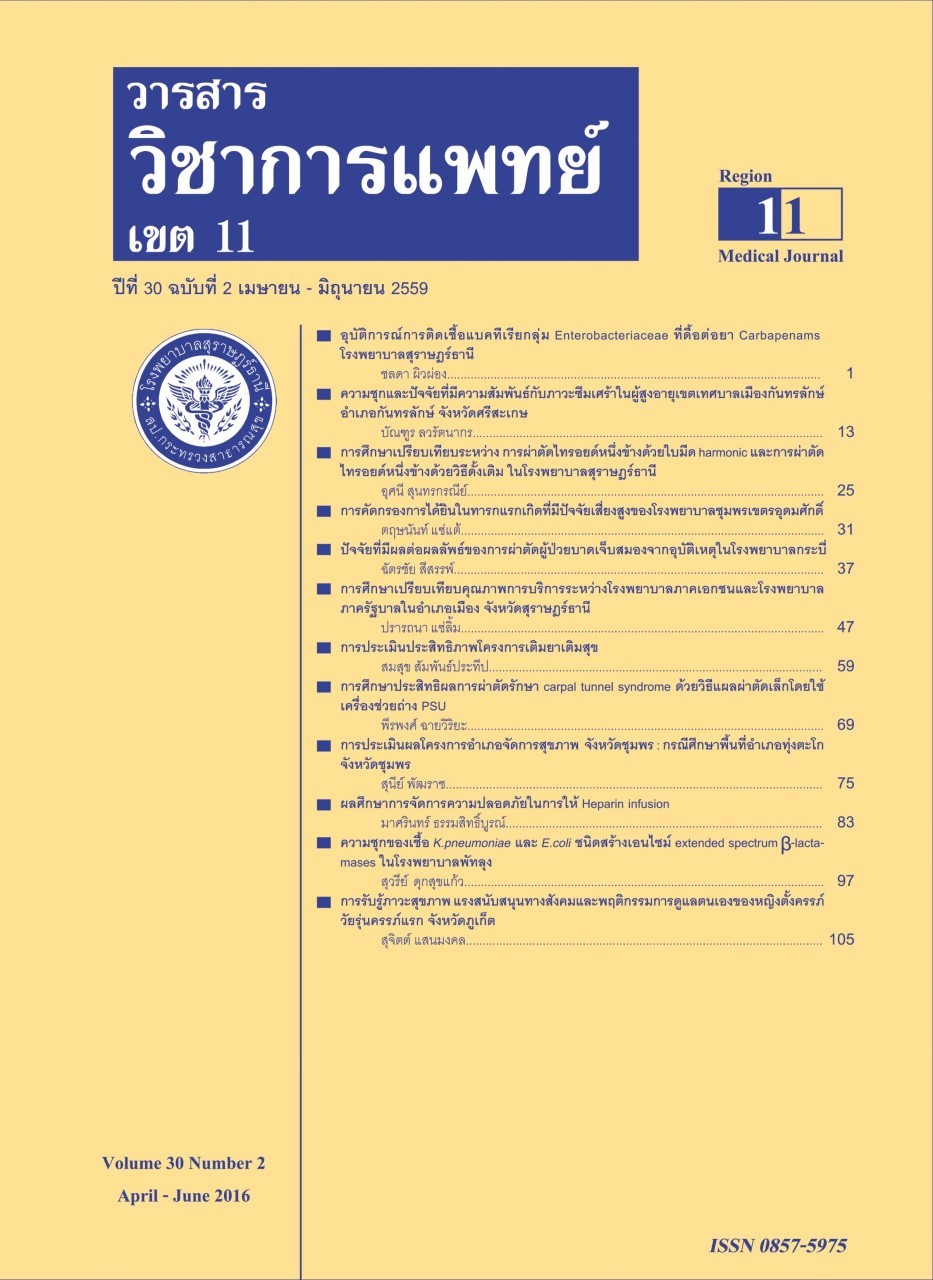High-Risk Neonatal Hearing screening program at Chumphon Khet Udomsak hospital
Keywords:
neonatal hearing screening, Otoacoustic emissionsAbstract
Methods : Review of hearing screening test in high risk newborns who met the high-risk criteria according to Joint Committee of Infant Hearing 1994, American Academy of Pediatrics, which admitted at Department Of Pediatrics, Chumphon Khet Udomsak hospital from June 2013-December 2014. Descriptive
analysis was used for the prevalence of pathologic hearing test results.
Results : One hundred and forty-nine infants were screened with Otoacoustic emission (OAE) test. The prevalence of pathologic hearing screening test was 3.4%with unilateral and bilateral pathologic results in 2 and 3 infants (1.4% and 2%). Four top risk factors were ototoxic drugs, very low birthweight infants (<1,500 grams),low Apgar score, on mechanical ventilation more than 5 days.
Conclusion : Otoacoustic emissions are non invasive technique and suitable for hearing screening in high risk infants
References
2. Parving A. Congenital hearing disability: epidemiology and identification; A comparison between two health authority districts. Int J PediatrOtoloaryngol 1993; 27:29-46.
3. White KR, Behrens TR. The Rhode Island hearing assessment project: implications for universal newborn hearing screening. Semin Hear 1993;14:1-119.
4. Watkin PM. Neonatal otoacoustic emission screening and the identification of deafness. Arch Dis Child 1996;74: F16-25.
5. Mason JA, Herrmann KR. Universal infant hearing screening by automated auditory brainstem response measurement. Pediatrics 1998;101:221-8.6
6. Erenberg A, Lemoms J, Sia C, Ziring P. Newborn and infant hearing loss: detection and intervention. American Academy of Pediatrics.Task Force on Newborn
and Infant Hearing. 1998-1999. Pediatrics 1999;103(2):527-30.
7. Northern JL, Downs MP. Hearing screening in children. In: Northern JL, Downs MP, editors. Hearing in Children. 5th ed. Baltimore: Lippincott Williams &
Wilkins; 2002. p.259-300.
8. Nelson HD, Bougatsos C, Nygren P. Universal newborn hearing screening: Systematic review to update the 2001 U.S. preventive service task force recommendation. Pdeiatrics 2008;1221(1):e266-76
9. White KR, Vohr BR, Behrens TR, Universal newborn hearing screening using transient evoked otoacousticemission:result of the Rhode Island Hearing
Assessment Project. Semin Hear 1993;14:18-29
10. Mauk GW, White KR, Mortensen LB, Behrens TR. The effectiveness of screening programs based on high-risk characteristics in early identification of hearing
loss. Ear Hear 1991;12:312-9
11. Joint committee on infant Hearing: American Academy of Audiology; American Academy of Pediatrics; American Speech-Language-HearingAsssociation;
Director of Speech and Hearing Programs in State Health and Welfare Agencies. Year 2007 position statement: principle and guidelines for early hearing
detection and intervention programs. Pediatrics 2008;120(4):898-921
12. Joint committee on infant Hearing: American Academy of Audiology; American Academy of Pediatrics; American Speech-Language-HearingAsssociation;
Director of Speech and Hearing Programs in State Health and Welfare Agencies. Year 2000 position statement: principle and guidelines for early hearing
detection and intervention programs. Pediatrics 2000;120(4):898-921
13. จันทร์ชัย เจรียงประเสริฐ, กฤษณา เลิศสุขประเสริฐ, ลลิดา เกษมสุวรรณ, ประชา นันท์นฤมิต. การตรวจคัดกรองการได้ยินในทารกแรกเกิดด้วยเครื่องตรวจวัดเสียงสะท้อน
จากหูชั้นใน(Otoacoustic emission): ผู้ป่วยใหม่ใน 1 ปี ของโรงพยาบาลรามาธิบดี. วารสารหู คอ จมูกและใบหน้า 2546;4(1):27-41
14. Kaimook W, Chayarpham S, Dissaneevate S, The high risk neonatal hearing screening program in Songkanagarind Hospital. J Med Assoc Thai 2008;91(7):1038-42
15. SrisuparpP, Gleebbur R, Ngerncham S, Chonpracha J, Singkampong J, High-risk neonatal hearing screening program using automated screening device
performed by trained nursing personnel at Siriraj Hospital: yield and feasibility. J Med Assoc Thai 2005;88(Suppl 8):S176-82.
16. วันชัย ตั้งอารมณ์มั่น. การตรวจคัดกรองการได้ยินในทารกแรกเกิดและทารกกลุ่มเสี่ยงโดยใช้เครื่องวัดเสียงสะท้อนจากหูชั้นใน.พุทธชินราชเวชสาร2551;25:618-24.






